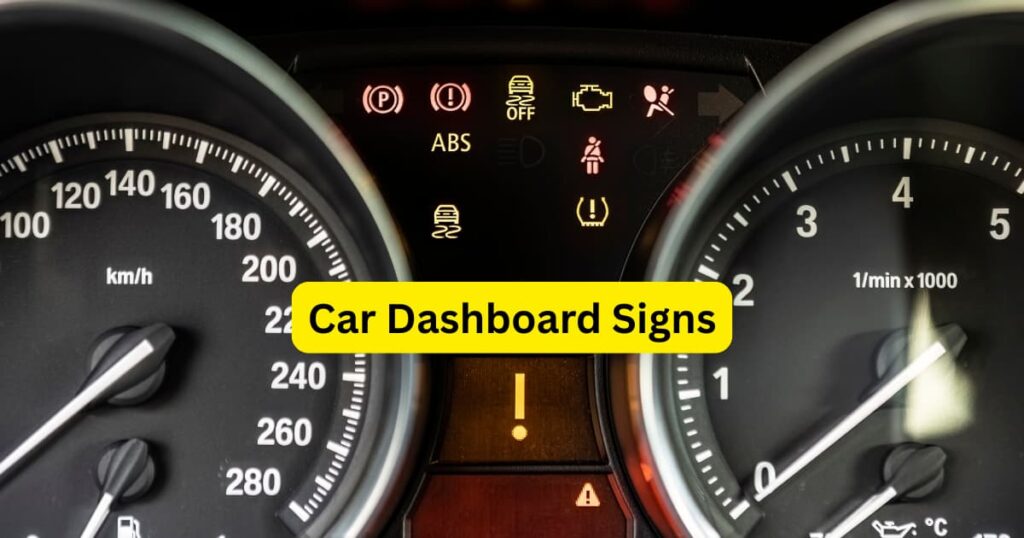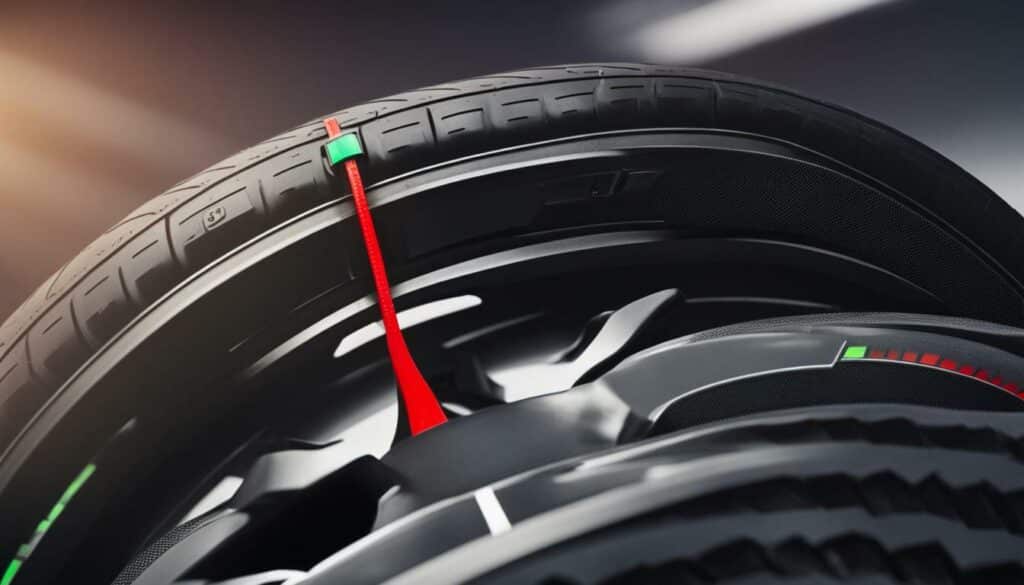It’s a scenario every driver is familiar with: you’re cruising down the motorway, enjoying the scenic New Zealand landscape, when suddenly, a small, cryptic light illuminates on your dashboard. A moment of panic might set in. What does it mean? Is it serious? Do I need to pull over immediately?
Here at Kiwi Motor Hub, we understand that modern vehicles are complex machines, and their dashboards can sometimes feel like the cockpit of an aeroplane. But fear not! My goal is to demystify these symbols and provide you with a comprehensive guide to understanding your car dashboard signs. As a Kiwi driver, being able to interpret these signals is crucial for your safety, the longevity of your vehicle, and even for passing your next Warrant of Fitness (WOF).
Think of your car’s dashboard lights as its way of communicating with you. They provide vital information about the health and status of your vehicle. By understanding what they’re trying to tell you, you can address potential issues before they become major, costly problems. This knowledge empowers you to make informed decisions, whether it’s simply topping up your washer fluid or seeking immediate professional help.
Most modern cars use a colour-coded system for their dashboard lights, much like a traffic light, to indicate the urgency of the message. This is a great starting point for quickly assessing the situation.
To make it easier for drivers to quickly understand the severity of a potential issue, most vehicle manufacturers use a standardised colour-coding system for their dashboard warning lights. This system is intuitive and easy to remember, following the familiar traffic light pattern of red, yellow (or orange), and green (or blue).
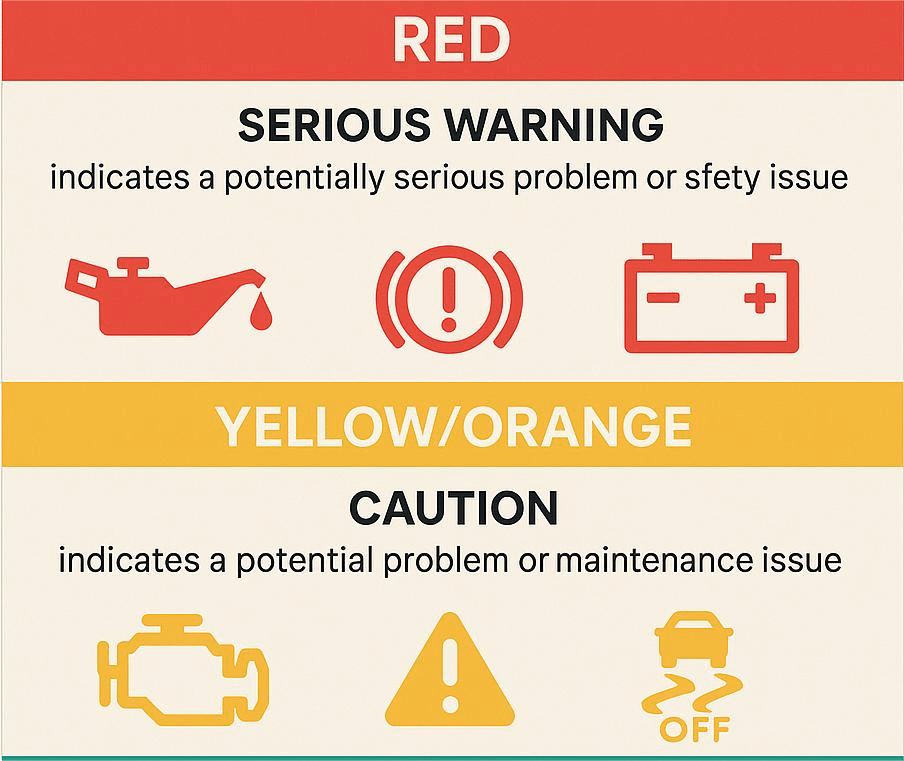
| Colour | Meaning | Action Required |
| Red | Serious Warning | Stop the vehicle as soon as it is safe to do so and seek immediate attention. |
| Yellow/Orange | Caution | The system requires attention. It is generally safe to continue driving, but you should have the issue checked as soon as possible. |
| Green/Blue | Informational | A system is currently active (e.g., headlights are on). No action is required. |
Understanding this basic principle is the first step to becoming a more confident and informed driver. In the following sections, I’ll delve deeper into the specific symbols you’re likely to encounter, starting with the most critical red warnings.
The Most Critical Red Warning Lights
When a red warning light appears on your dashboard, it’s your car’s way of shouting for immediate attention. These are the most serious warnings, and ignoring them can lead to severe mechanical damage or even compromise your safety. Here’s a breakdown of the most critical red warning lights you need to know.
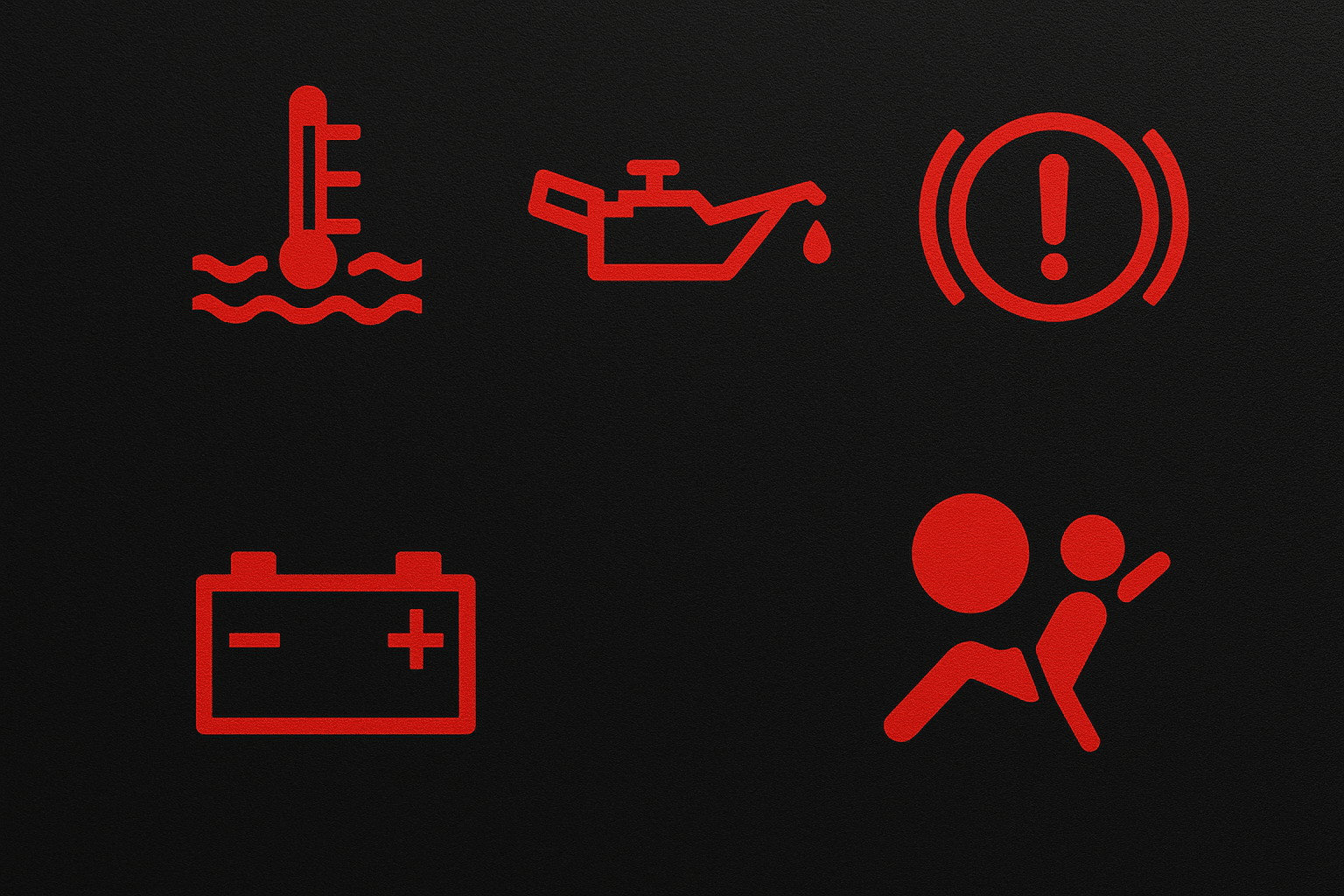
What it means: This light, often resembling a thermometer submerged in liquid, indicates that your engine is overheating. This is a serious issue that can cause significant and often irreparable damage to your engine.
What to do: If this light comes on, you should pull over and stop your car as soon as it is safe to do so. Turn off the engine and allow it to cool down completely before attempting to check the coolant level. Do not open the radiator cap when the engine is hot, as the pressurised coolant can cause severe burns.
Potential consequences of ignoring it: Continuing to drive with an overheating engine can lead to a blown head gasket, warped cylinder heads, or even complete engine seizure. These are some of the most expensive repairs a car can have.
Oil Pressure Warning Light
What it means: The oil can symbol indicates a loss of oil pressure. This means that the oil is not circulating properly to lubricate the moving parts of your engine. This could be due to a low oil level, a faulty oil pump, or a leak in the system.
What to do: This is one of the most critical warnings. Stop the car immediately and turn off the engine. Check the oil level using the dipstick and look for any obvious leaks under the car. If the oil level is low, topping it up may solve the problem. However, if the light remains on after topping up, do not drive the car. Have it towed to a mechanic.
Potential consequences of ignoring it: Driving with low oil pressure can cause catastrophic engine failure within minutes. The lack of lubrication will cause the engine’s moving parts to grind against each other, leading to seizure.
Brake System Warning Light
What it means: This light, typically an exclamation mark inside a circle, can indicate a few different issues with your brake system. It could mean that your handbrake is on, that your brake fluid is low, or that there is a more serious problem with the hydraulic system.
What to do: First, ensure that your handbrake is fully released. If the light remains on, pull over safely and check your brake fluid level. If it’s low, you can top it up, but you should still have your brake system inspected for leaks. If the brake pedal feels spongy or goes to the floor, do not drive the car.
Potential consequences of ignoring it: Your brakes are your car’s most important safety feature. Ignoring a brake warning light could lead to brake failure, which could have devastating consequences.
Battery Charge Warning Light
What it means: This light, shaped like a car battery, indicates that the battery is not being charged. This is usually due to a problem with the alternator, the voltage regulator, or the wiring.
What to do: You can continue to drive for a short distance, but you should turn off all non-essential electrical components, such as the radio and air conditioning, to conserve battery power. Drive directly to a mechanic to have the charging system inspected.
Potential consequences of ignoring it: If you continue to drive, your car will run on battery power alone, and it will eventually die. This could leave you stranded in an inconvenient or unsafe location.
Airbag Warning Light
What it means: This light, showing a person with an airbag, indicates a fault in the airbag system. This could be a problem with the airbags themselves, the sensors, or the seatbelt pre-tensioners.
What to do: While the car is still drivable, you should get the system checked by a professional as soon as possible. In the event of an accident, the airbags may not deploy, or they could even deploy unexpectedly.
Potential consequences of ignoring it: The airbag system is a critical safety feature. If it’s not working correctly, you and your passengers are at a much higher risk of serious injury in a crash.
Important Yellow & Orange Warning Lights
Yellow or orange warning lights are less critical than red ones, but they still require your attention. These lights indicate that a system in your car needs to be checked or serviced soon. While you can usually continue driving, it’s best to address the issue as soon as possible to prevent it from becoming a more serious problem.
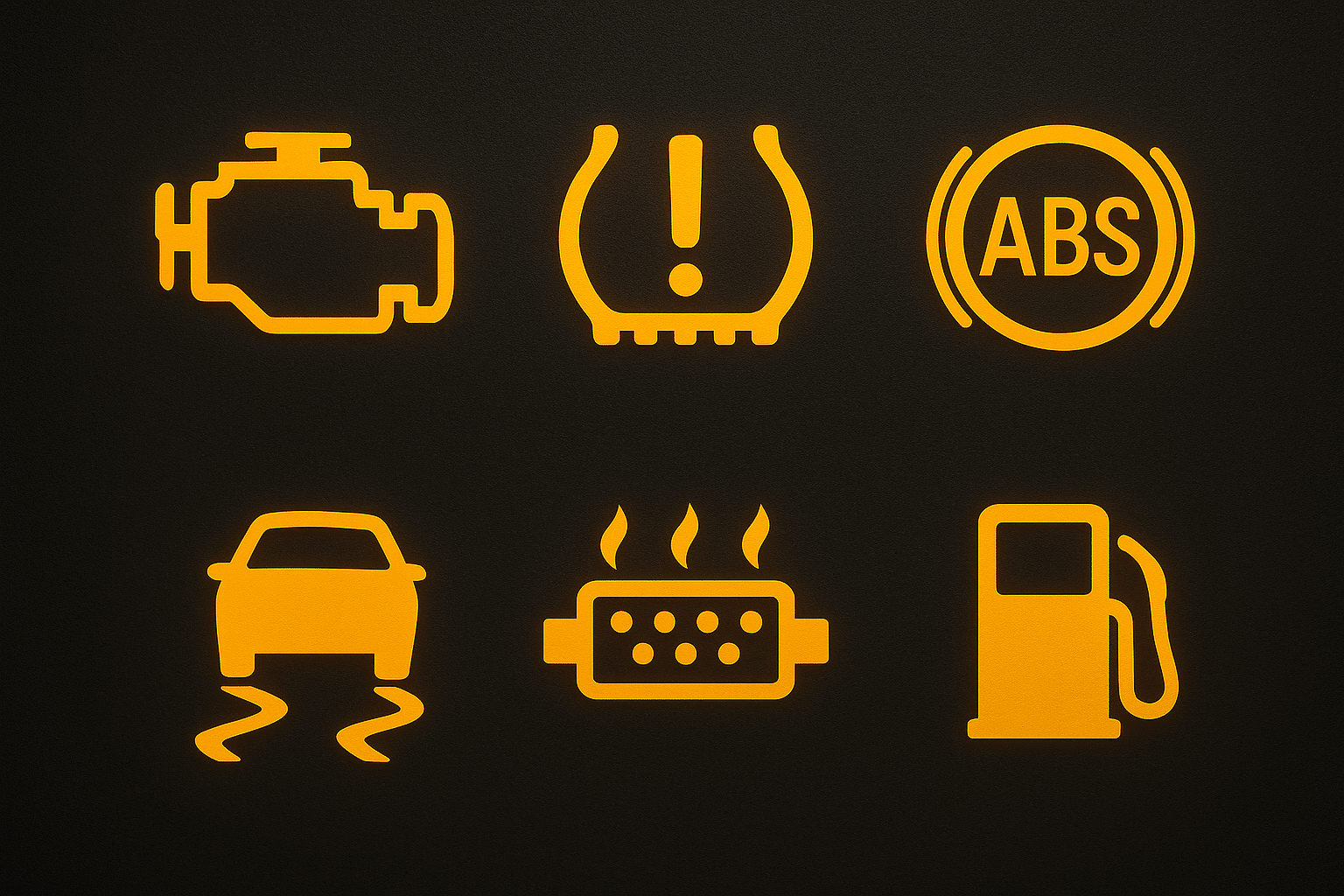
Check Engine Light
What it means: This light, also known as the Malfunction Indicator Lamp (MIL), is one of the most misunderstood dashboard warnings. It can light up for a wide variety of reasons, from a loose petrol cap to a serious engine problem. The light indicates that the car’s onboard computer has detected a fault in the engine or emissions system.
What to do: If the check engine light is steady, you can continue driving, but you should have your car checked by a mechanic as soon as you can. If the light is flashing, it indicates a more serious problem, such as a misfire, that could damage your catalytic converter. In this case, you should pull over and have your car towed to a mechanic.
Tire Pressure Monitoring System (TPMS)
What it means: This light, which looks like a tire in cross-section with an exclamation mark, indicates that the pressure in one or more of your tires is low. Driving with underinflated tires can affect your car’s handling, increase braking distance, and cause the tires to wear out prematurely.
What to do: Find a safe place to pull over and check your tire pressures. You can find the recommended tire pressure for your car on a sticker inside the driver’s door jamb. If you have a portable air compressor, you can inflate the tires to the correct pressure. If not, drive carefully to the nearest petrol station with an air pump.
Anti-lock Braking System (ABS)
What it means: The ABS light indicates a problem with the anti-lock braking system. The ABS helps to prevent your wheels from locking up during heavy braking, allowing you to maintain steering control. When this light is on, your normal brakes will still work, but the ABS function will be disabled.
What to do: You can continue to drive, but you should be aware that the ABS is not working. This means you’ll need to be more careful when braking, especially in wet or slippery conditions. Have the system checked by a mechanic as soon as possible.
Traction Control/Stability Control
What it means: This light, often showing a car with squiggly lines behind it, indicates that the traction control or stability control system has been activated. These systems help to prevent your wheels from spinning and your car from skidding. It’s normal for this light to flash briefly when you’re driving on a slippery surface.
What to do: If the light flashes, it’s just letting you know that the system is working. If the light stays on, it may indicate a fault in the system. You can still drive the car, but you should be more cautious in slippery conditions. Some cars also have a button to turn this system off, so make sure you haven’t accidentally pressed it.
Diesel Particulate Filter (DPF) Warning
What it means: This light is specific to diesel vehicles and indicates that the diesel particulate filter is blocked with soot. The DPF is part of the exhaust system and is designed to trap harmful particles.
What to do: To clear the blockage, you may need to drive for 15-20 minutes at a steady speed of over 60 km/h. This will allow the exhaust system to get hot enough to burn off the soot. If the light remains on after this, you should take your car to a mechanic.
Low Fuel Level
What it means: This is one of the most common and easily understood warning lights. It simply means that you’re running low on fuel and need to fill up soon.
What to do: Don’t push your luck! Head to the nearest petrol station and fill up your tank. Running your car completely out of fuel can damage the fuel pump.
Informational Green & Blue Lights
Not all dashboard lights are warnings. Green and blue lights are purely informational, letting you know that a particular system is active. Here are some of the most common ones you’ll see.
Headlight Indicators: A green light shaped like a jellyfish or a letter ‘D’ with lines coming off it indicates that your low beam headlights are on. A blue light with straight lines indicates that your high beams are on. Remember to dip your high beams for oncoming traffic!
Fog Light Indicator: This green or yellow symbol, a lamp with a wavy line through the beams, shows that your fog lights are on. Only use these in foggy conditions, as they can be dazzling to other drivers.
Cruise Control Indicator: When you activate your cruise control, a green light, often looking like a speedometer with an arrow, will appear on your dashboard to let you know that the system is active.
Turn Signal Indicators: These are the flashing green arrows that indicate which way you are turning. It’s a basic but essential part of driving, and it’s important to make sure they are working correctly.
Dashboard Lights and Your Warrant of Fitness (WOF)
In New Zealand, your car’s dashboard warning lights are more than just helpful indicators; they can also affect your ability to get a Warrant of Fitness (WOF). The WOF inspection includes a check of certain safety-related dashboard warning lights to ensure they are functioning correctly. [1]
Specifically, the inspector will check that the warning lights for the anti-lock braking system (ABS) and the airbag system illuminate when the ignition is turned on and then go out. If these lights do not light up at all, or if they remain on, your car will fail its WOF. This is because a malfunctioning warning light could indicate a serious fault in these critical safety systems.
It’s a good idea to check these lights yourself before you go for a WOF. Simply turn your ignition to the “on” position without starting the engine and check that the ABS and airbag lights come on and then turn off after a few seconds. If they don’t, it’s best to get them checked by a mechanic before your WOF inspection.
What to Do When a Warning Light Comes On
Seeing a warning light on your dashboard can be stressful, but it’s important to stay calm and take a systematic approach. Here’s a simple step-by-step guide to follow:
flex flex-row justify-center items-center h-[30px] w-[24px] me-[2px] whitespace-nowrap flex-shrink-0″ contenteditable=”false”>1.Don’t panic. Most warning lights are not emergencies. Take a deep breath and focus on driving safely.
2.Identify the light and its colour. Is it red, yellow/orange, or green/blue? This will give you an immediate indication of the severity of the issue.
3.Consult your car’s manual. Your car’s manual will have a detailed section explaining what each dashboard light means and what you should do.
4.Assess the situation. Is the car behaving differently? Are there any strange noises, smells, or vibrations? Is there a loss of power? Your observations can provide valuable information to a mechanic.
5.Take appropriate action. Based on the colour of the light and the information you’ve gathered, decide on the best course of action. This could be anything from pulling over immediately and calling for a tow, to driving carefully to a mechanic, to simply making a note to get it checked at your next service.
